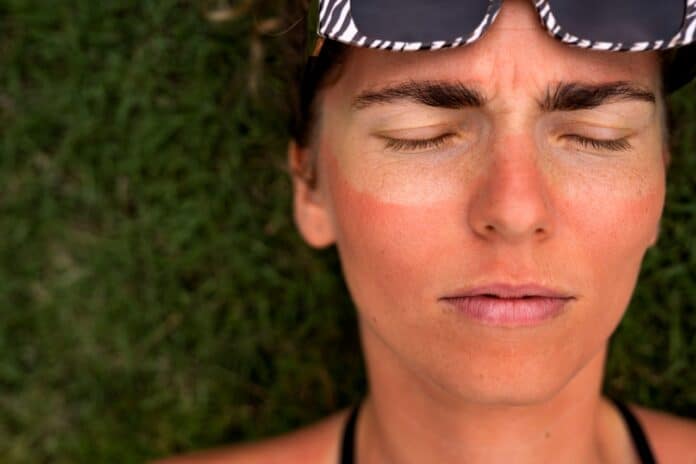As the sun’s warm embrace draws us outdoors, we often bask in its rays, seeking the golden glow of a sun-kissed complexion. However, prolonged exposure to the sun’s ultraviolet (UV) radiation can lead to more than just a tan. Many of us have experienced the consequences of overexposure: once supple and smooth, our skin transforms into a “leathery” texture.
This puzzling phenomenon has captured the attention of Binghamton’s dedicated bioengineers, who are delving into the cellular breakdown processes that underlie this curious transformation. In this exploration, we will uncover the scientific mysteries behind why skin becomes “leathery” after too much sun exposure and learn about the groundbreaking research conducted to understand and mitigate the effects of UV radiation on our skin.
For years, excessive sun exposure toughening the skin, resulting in “leathery” complexions, has been widely accepted but not thoroughly understood. However, Binghamton University researchers recently addressed this knowledge gap by conducting a groundbreaking study published in the Journal of the Mechanical Behavior of Biomedical Materials.
Their investigation focused on how ultraviolet radiation impacts the microstructure of human skin, explicitly examining collagen—the crucial fibrous protein responsible for the strength and structure of tissues, tendons, cartilage, and bones. Through this research, they aim to unravel the mysteries surrounding the skin’s response to UV radiation exposure and its transformation into a “leathery” texture.
The Department of Biomedical Engineering at the Thomas J. Watson College of Engineering and Applied Science spearheads groundbreaking research led by Ph.D. student Abraham Ittycheri and Zachary Lipsky, Ph.D. ’21, Assistant Professor Tracy Hookway and Associate Professor Guy German. Expanding on earlier studies by German and Lipsky, which concentrated on the outer stratum corneum, the team is now examining full-thickness skin samples before and after exposure to different ultraviolet (UV) radiation levels.
Ittycheri said, “One way to characterize the material characteristics of skin is by conducting a mechanical stretch test on it. If it stretches very easily, it’s relatively compliant. However, if it’s much harder to stretch it, you can characterize it as much stiffer. My experiment was to see the isolated effects of UV light and compare it with a scenario where the skin is not exposed to UV light.”
The researchers’ findings revealed that increased UV radiation absorption resulted in collagen fibers within the skin becoming more tightly packed, leading to heightened stiffness and stricter tissue. Associate Professor Guy German draws connections to the cross‐linkage theory of aging, suggesting that accumulating undesirable molecular bonds over time could cause cellular dysfunction. While the researchers caution against instilling fear regarding sun exposure, they highlight that prolonged UV light exposure can toughen the skin and raise the risk of carcinogenic issues.
Assistant Professor Tracy Hookway, known for her cardiac cell research and recipient of the National Science Foundation CAREER Award, notes similarities between how heart and skin cells respond to damage, emphasizing the body’s natural compensatory mechanisms when confronted with tissue weakening or injury. This adaptation is akin to how scar tissue forms in the heart after myocardial infarction, altering its function.
Assistant Professor Tracy Hookway highlights that although the body’s reaction to damage can keep a person alive, it may lead to undesirable outcomes and potential medical issues later on. Understanding the underlying mechanics of these processes could empower future doctors to steer reactions toward healthier outcomes. In light of their research, collaborations between Ittycheri, German, and Hookway are underway.
Considering that our skin is the body’s largest organ and primary defense against external threats, finding ways to maintain and strengthen it holds significant benefits. Any disruptions to the skin’s normal processes can be perilous to overall well-being, as Abraham Ittycheri emphasizes, not to mention the psychological impact when one’s skin does not look its best from a cosmetic standpoint.
Understanding the mechanical and structural changes UV radiation induces in human skin holds significant implications for future medical practices. The research findings may pave the way for doctors to manipulate these reactions in a healthier direction, thereby mitigating potential skin-related medical issues. Additionally, this knowledge can aid in developing better strategies to maintain and strengthen the skin’s natural defense mechanisms against external threats and microbial attacks.
Journal Reference:
- Abraham Ittycheri, Zachary W. Lipsky et al., Ultraviolet light induces mechanical and structural changes in total thickness human skin. Journal of the Mechanical Behavior of Biomedical Materials.DOI:10.1016/j.jmbbm.2023.105880.
